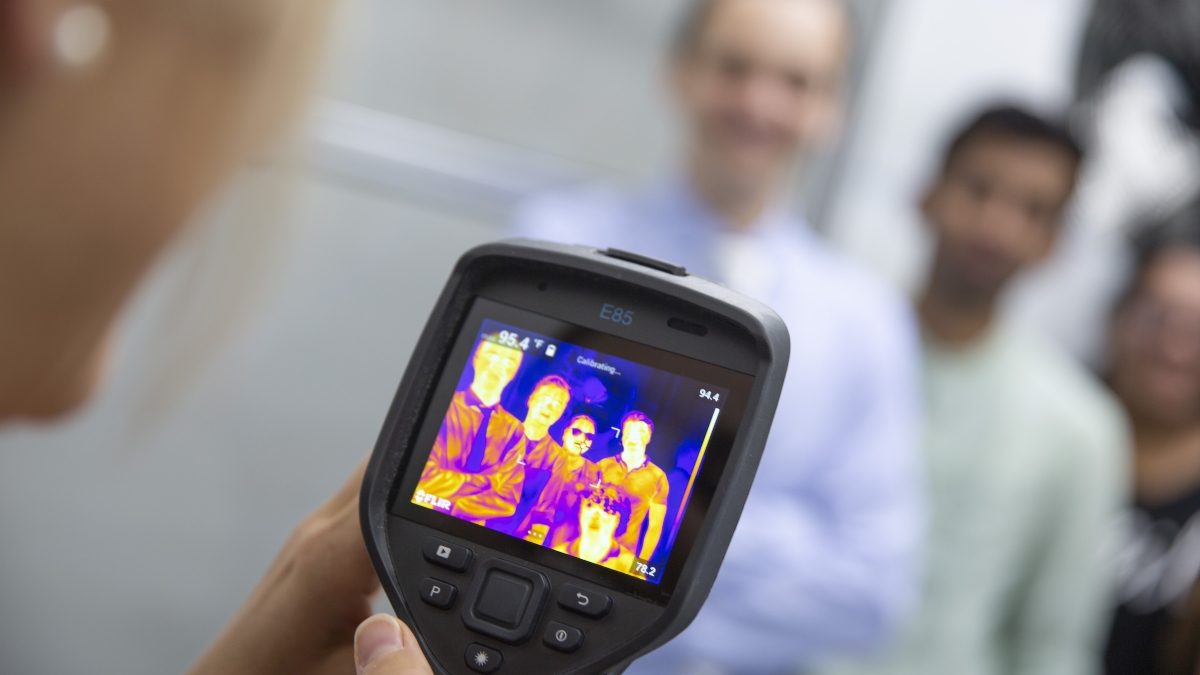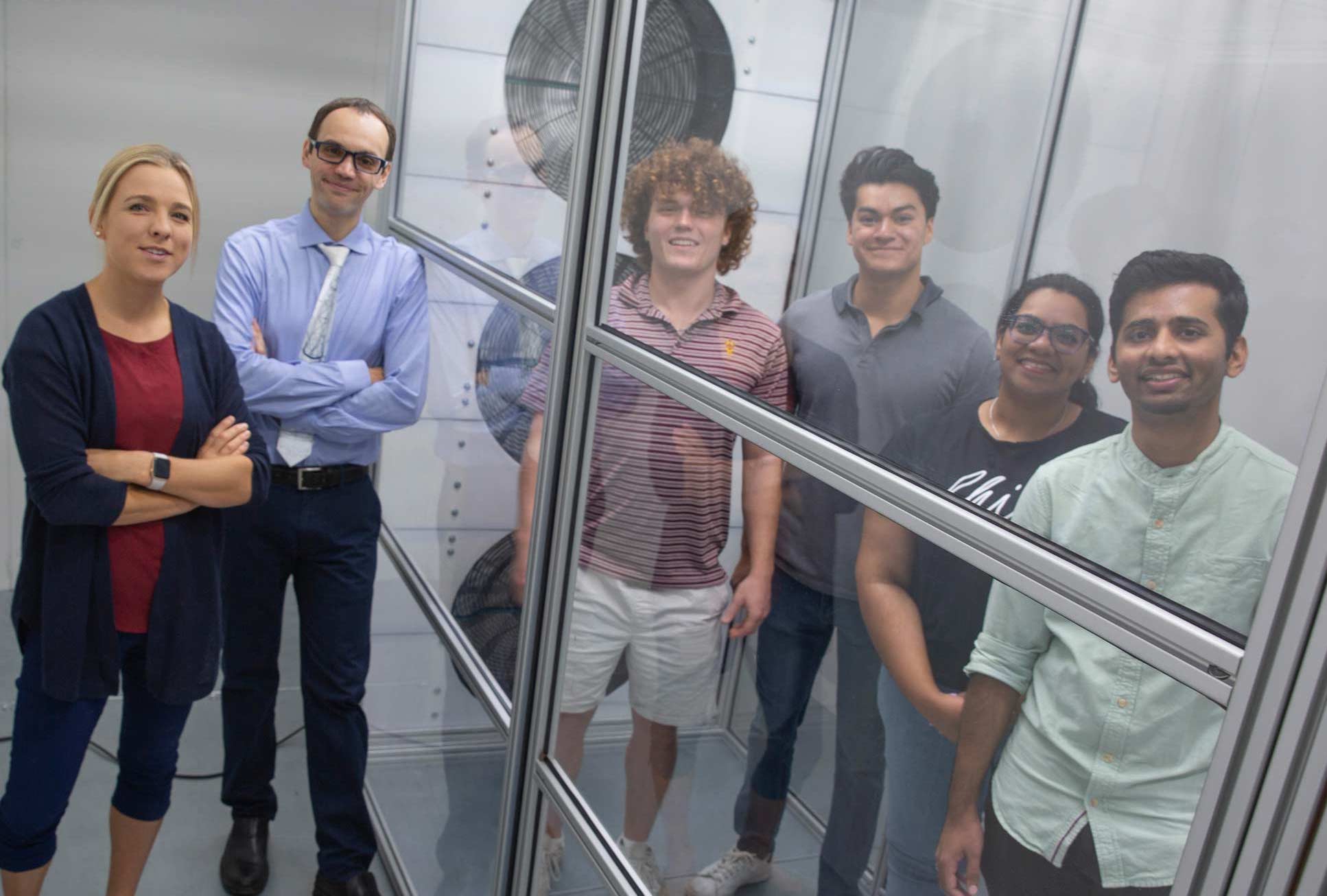"The heat is on” — a phrase used to figuratively express a high-pressure situation or even an imminent threat — describes what Konrad Rykaczewski says we, as the human inhabitants of Earth, are actually facing today in a world in which actual heat and its consequences are intensifying.
Increasing temperatures are already having dramatic impacts that are expected to accelerate until we find ways to better shield ourselves from the heat or adapt to live with it, says Rykaczewski, an associate professor of mechanical engineering in the School for Engineering of Matter, Transport and Energy, part of the Ira A. Fulton Schools of Engineering at Arizona State University.
Due to climate change and poor working and living conditions in many places around the world, overexposure to heat is expected to remain a persistent threat to human well-being as a major cause of illness and death, an impediment to quality of life and a drag on economic activity and prosperity, says Rykaczewski, who is also a researcher in ASU’s Julie Ann Wrigley Global Futures Laboratory.
A report from the U.S. Occupational Safety and Health Administration and information from the National Heart, Lung and Blood Institute confirm why rising temperatures are cause for serious concern.
Rykaczewski says a big roadblock to solutions is the lack of a comprehensive understanding of the progression of the physical dangers posed by extreme heat exposure, both indoors and outdoors, from simple physical discomfort to heat stress, physical strain, sickness and loss of life.
In the quest to find better ways to prevent heat overexposure and also adequately cope with it when it happens, Rykaczeswki is teaming with ASU colleagues he has been collaborating with for three years, Assistant Professor Ariane Middel and Associate Professor Jennifer Vanos.
Middel, who has joint faculty positions in the School of Computing and Augmented Intelligence and the School of Arts, Media and Engineering, is an urban climatologist focusing on the development of urban design and infrastructure to protect people from perils posed by extreme heat and climatic uncertainty.
Vanos, a faculty member in ASU’s School of Sustainability, works with Middel in ASU’s Urban Climate Research Center. Her expertise includes studies of sustainable and healthy urban spaces with an emphasis on extreme heat, air pollution and vulnerable populations.
Their work with Rykaczewski has been focusing on better ways to protect those populations from debilitating heat exposure. The results of their work have recently earned $2 million in funding over the next four years from the National Science Foundation's Leading Engineering for America’s Prosperity, Health, and Infrastructure program.
“This funding allows us to come at this big societal challenge of extreme heat impacts on health from multiple angles due to our diverse backgrounds,” Vanos says. “Because of this, our approaches are novel and will enable us to study the problem in new ways, helping us create new methods and solutions. It’s exactly what the NSF wants in convergence research.”

A human-shaped thermal manikin named ANDI, equipped with sensors and other technologies to measure the effects of human exposure to different heat intensities, is helping researchers determine the human thermoregulatory system’s response to different heat exposure conditions. The manikin is attached to an apparatus that enables it to simulate walking, and its blue covering helps to simulate sweating on its surface. Photo courtesy of Thermetrics
With that support, they are developing next-generation experimental tools to measure heat exposure and complementary models to better predict the effects of human interaction with warm to extremely hot environments.
They’ll use the tools and models to provide extensive data about human exposure to heat and the potential effects on diverse populations in differing environmental scenarios, as well as ways to effectively deal with extreme heat in various circumstances.
Among the expected outcomes are new fieldwork methods to quantify the impacts of convective and radiative heat fluxes on 35 parts of the human body and the progression of the resulting heat stress and strain triggered by extreme heat conditions in different built environments.
Among the tools they are using is a mobile biometeorological sensing station named MaRTy, created and deployed by Middel for her work to help metropolitan areas confront urban heat-island effects that have been escalating rapidly in high-population regions in recent years.
There’s also ASU ANDI, a human-shaped and sensor-equipped manikin made by Thermetrics, a developer of thermal testing equipment technology, including thermal manikin systems. A manikin is a life-size anatomical model used to represent the human form for medical studies and other scientific experimentation, research and education.
Thermal manikins can be instrumented to measure the effects of human exposure to different heat intensities and mimic the human thermoregulatory system’s response to different thermal situations. ANDI, for example, generates "metabolic" heat, sweats, breathes and walks, Rykaczewski says.
For ASU’s purposes, the ANDI manikin, funded by a $413,000 NSF Major Research Instrumentation Program grant awarded to Rykaczewski, Vanos, Middel and others in 2021, has been modified to enable measurements in extremely hot indoor and outdoor settings.
“Our manikin can be exposed to extreme heat longer than what could be safely done with human subjects, so it enables unique measurements of current and future climate impacts on people,” Rykaczewski says.
When not being used in the field, ANDI will reside in a new environmental chamber that is part of the Human Biometrology Lab directed by Vanos in ASU’s Rob and Melani Walton Center for Planetary Health.
The temperature, humidity, radiation and wind in the chamber can be adjusted to expose ANDI not only to simulations of the hottest summer day in Arizona, but also to the most humid summer heat in Florida — as well as even hotter climates expected in the future, Rykaczewski says.
Seed funding from Fulton Schools has been used to equip the chamber with a walk-in wind tunnel that can expose the manikin to airflow of up to 4.5 miles per hour.
The tunnel was built by Rykaczewski, Vanos and Middel, along with Fulton Schools senior mechanical engineering students Lyle Bartels and Daniel Martinez, mechanical engineering graduate student Shri Harri Viswanathan and aerospace engineering graduate student Sai Susmitha Guddanti.

Assistant Professor Ariane Middel, an affiliate in ASU’s Urban Climate Research Center, adjusts instruments on MaRTy, a mobile biometeorological sensing station. MaRTy is among the tools that will be used to provide data for a new ASU research project aimed at developing ways to protect people, especially vulnerable populations, from overexposure to extreme environmental heat. Photo by Deanna Dent/ASU
Through ANDI’s capabilities and other advanced tools, the research team expects to develop more precise ways to quantify the impacts of heat on humans.
“ANDI and MaRTy will become best friends, conducting a lot of outdoor field work together,” Middel says. “MaRTy will measure the impact of the built environment on radiative fluxes, and ANDI can tell us how the human body will respond to those fluxes.”
The researchers will also develop compact environmental heat exposure models that link with computational manikins like ANDI. In addition, the team will compile a database of common indoor and outdoor “heatscapes.”
Those models will be used to develop personalized heat illness “riskscapes” to indicate the potential impacts of extreme heat across a range of physically diverse people in various segments of the U.S. population.
Rykaczewski says ANDI and the infrared thermography imaging that are important tools in this work should also be useful for producing visually striking multimedia demonstrations that the team can use to showcase the results of its research at public exhibits, including at the popular ASU Open Door.
In a related project also supported by the NSF, Rykaczewski and Professor Stavros Kavouras, assistant dean of ASU’s College of Health Solutions, are exploring various aspects of human sweat. Their goal is to measure the microscale dynamics of sweat evaporation in various contexts across a large set of environmental complexities and situational variants.
Considering the role sweat plays in the body’s thermoregulation process, Rykaczewski says there is still too little known about the underlying workings of thermofluidic mechanisms on a sweat gland-length scale.
He and Kavouras will combine physiological and engineering approaches in efforts to significantly expand quantitative information about the process of sweat evaporation.
That information should yield new data relevant to fields ranging from the development of new medical diagnostics and health care practices to the design of built environments in ways that provide protection from severe overheating.
An environmental chamber being used for heat exposure research is providing a range of adjustable temperatures, humidity levels, radiation and wind conditions to test the impacts of various thermal environments on people. Outside the chamber (from left) are two of the research leaders, Associate Professor Jennifer Vanos and Associate Professor Konrad Rykaczewski. Inside the chamber (from left) are mechanical engineering students Lyle Bartels and Daniel Martinez, aerospace engineering graduate student Sai Susmitha Guddanti and mechanical engineering student Shri Harri Viswanathan, who are assisting in the research and constructed the chamber. Photo by Erika Gronek/ASU
The researchers foresee results of the two projects improving methods and devices for assessing the heat exchange and transfer processes between our bodies and various surrounding environments.
“We want to provide new knowledge that can help guide the making of more intelligently designed public infrastructure, buildings, homes and even clothing that will shield people from overexposure to heat,” Rykaczewski says.
That knowledge could lead to advances in manufacturing clothing that better protects the body from heat, as well as optimizes air flow and air conditioning systems to provide more thermal comfort in workplaces, modes of transportation and structures of all sizes, shapes and building materials.
The scope of support for these projects will also allow ASU researchers to provide Thermetrics, which is the team’s industrial partner in the NSF-funded Grant Opportunities for Academic Liaison with Industry (GOALI) sweat project, with the know-how to design a more realistic “sweating skin” that would boost the capabilities of the company’s thermal manikins.
Top photo: Infrared thermography is a tool ASU researchers are using to better understand the build-up and movement of environmental heat. Thermographic imagers detect how heat radiates from objects, producing images of temperature distribution. Some types of infrared cameras can quantify spatial temperature and sweat droplet distribution on the human body on a sweat gland-length scale. Understanding that process and similar biological and environmental processes can lead to solutions for mitigating and coping with the impacts of high temperatures. Photo by Erika Gronek/ASU
More Science and technology

ASU researcher part of team discovering ways to fight drug-resistant bacteria
A new study published in the Science Advances journal featuring Arizona State University researchers has found vulnerabilities in certain strains of bacteria that are antibiotic resistant, just…

ASU student researchers get early, hands-on experience in engineering research
Using computer science to aid endangered species reintroduction, enhance software engineering education and improve semiconductor material performance are just some of the ways Arizona State…

ASU professor honored with prestigious award for being a cybersecurity trailblazer
At first, he thought it was a drill.On Sept. 11, 2001, Gail-Joon Ahn sat in a conference room in Fort Meade, Maryland. The cybersecurity researcher was part of a group that had been invited…

